Fork Spring Replacement (VTX 1800)
Posted by Bare | Last Updated May 27, 2014This is a walk-through for choosing and changing the fork springs on the VTX 1800. When I noticed that most stealers wanted well over $100 to install these, I thought it was crazy. Why would I pay more than twice the price of the item to get it installed? This is a great mod for only a few bucks if you install them yourself.
I did this to swap to the stiffer Progressive 11-1520 springs in order to improve the overall handling and performance of the bike. The springs are also a big help with braking too. Let me give a big thanks to Chet over at Rattlebars for providing the text-based walkthrough that has helped thousands of riders change their springs in the past. My walk-through here is written not to overshadow his work, but to expound upon it by providing a more in depth idea of what this project entails by including pics as well as information on different springs you can use. This is a pretty simple job which requires only a few basic tools, a torque wrench, and like all mods – some patience. As always undertake this project at your own risk, but with a little common sense this isn’t very hard to do. An extra set of hands can also help this project go a little faster and smoother. I’ve done so many of these that I can swap them in about 30 minutes, but I would say a first-timer should expect to spend 1-2 hours on this project.
Required tools/Materials
- Progressive 11-1520 fork springs or Progressive 11-1521 fork springs (for a Goldwing)
- A few ounces of your preferred fork oil (10W is recommended). One quart will do several bikes.
- Wire coat hanger
- Something to block the front wheel (2×6, phone book, bricks, whatever)
- Motorcycle lift
- Torque wrench capable of 14-72 ft/lbs
- Honda fork spring tool OEM part# 07VMA-MZ0010A – available from any dealer or ask to borrow one on the forums. You can also see how to make your own on my tools page.
- 15/16″ or 24mm socket
- 8mm allen socket
- 14mm wrench
- Very thin 17mm (spanner) wrench – If you don’t have one the stock toolkit has one that will work (see pic)
Choosing which springs
You can see above that you can choose to run Progressive 11-1520 fork springs made for the VTX or Progressive 11-1521 fork springs made for the Goldwing. Here are some of the differences between the 2 types, depending on your riding style and the looks you want from the bike. Hopefully this will help you make an informed decision.
| Goldwing (13.25″) vs stock (13″) | VTX (12.5″) vs stock (13″) |
Both shocks will give you a much improved ride over the stockers. They provide a stiffer ride (in a good way), prevent front end dive or “see-saw” type action when braking, and give an all around firm feel to the front end. It’s hard to explain what a vast difference this makes in the handling. It makes the bike “plant” better and feel firmer in turns too. In short, they improve handling, braking, and ride comfort.
The stock Honda springs are 13″ long, the Goldwing springs are 13.25″ long and the VTX springs are 12.5″ long. You can look at the pictures below to see them all side-by-side.
| Stock height (4″) | VTX height (5″) | Goldwing height (5.5″) |
Once the springs are installed the differing spring lengths/rates affect the front end by changing the ride height. The pictures above show you the installed differences from one set of springs to the next. These measurements were taken on parked bikes without much extra weight on the front end, so if you have windshields, fairings, lights, etc up front then the extra weight may have an impact on the finished ride height for your specific bike. Regardless, these pictures still give you a fair comparison of what each set of springs can do for you.
The stock springs give you about 4″ of exposed fork tube while the Progressive VTX springs push the front end up to show about 5″, and the Goldwing springs go all the way up to 5.5″. The fact that a shorter spring raises the front end by an inch should give you an idea of how much stiffer these new springs really are. The performance gains from either set of Progressive springs are comparable. Most guys go with the VTX version because of the price. The Goldwing springs are an additional $25-$30 for the set and most people aren’t willing to pay that much more for just an extra 1/2″ of clearance. If you really hit the curves a lot and drag pegs all day long, then maybe the extra bucks are well spent – it’s your decision to make.
Process
With your springs selected and all your tools on hand, you’re finally ready to get started. I always start projects around the tank by covering the tank and fender with a nice, clean, soft towel to help protect them if you drop something. Get the bike raised up on the lift and put something under the rear wheel to “block” it from falling backwards (see pic). If you are doing this on an R model VTX with stock bars and risers then you will need to remove the bars. With a thick towel protecting your tank you can unbolt the risers and lay the bars on the towel on the tank. This will get them out of your way without having to disconnect any wires or hoses.
With all that done we are ready to break the top pinch bolts loose using an 8mm allen socket. With these loose you then break the fork caps loose using either a 15/16″ or 24mm socket. As you loosen the fork caps it is easiest if you alternate between them by doing a few turns on one and then a few turns on the other until you can feel that the threads are disengaged. Since the weight of the front wheel is hanging the fork caps will not pop up when they are loose, but you can tell the threads have disengaged when you begin hearing a “click” as you loosen them.
With both fork caps loose raise the front wheel so the caps raise up. It may be necessary to give them an additional half-turn or so to be sure the threads are completely disengaged as you raise the front wheel. As you lift the wheel “block” it in place with something so it stays up (see pic). With all this done your fork caps should be raised up like they are in the picture below.
Right fork
Start with the right fork. Use the 17mm spanner wrench on the lock nut and the 15/16 or 24mm socket to disengage the fork cap from the damper rod. Unscrew the fork cap completely and set it aside, making sure to be careful not to adjust the lock nut from it’s current location. With the fork cap out of the way, measure the length that the damper rod protrudes through the lock nut so you can duplicate it later. I used a caliper because it was handy, you can use a ruler or whatever you have on hand as long as your measurement is accurate so you can reset this lock nut later.
If you printed these directions you can write the length here for later reference: _________________
Now use the 17mm wrench to loosen the lock nut until it’s almost removed, but DO NOT REMOVE IT ENTIRELY (see pic below). It’s wise not to loosen it past the top of the lock nut. If you remove the lock nut all the way it will fly across the room from the spring tension, and there’s no telling where it might end up, what it might hit, etc.
With the lock nut loose, this is where a friend comes in really handy. You need to compress the spring collar so that the spring seat stopper can be removed. There are lots of ways to do this., I used to use 2 of those offset screwdrivers that come in every Craftsman screwdriver set (you can see them in the pictures below). I have now developed a better way to do this on my own. I bent a coat hanger into the U-shaped tool seen in the picture on the right. I use mine a lot so I plasti-dipped the handle end, but you certainly don’t have to. If you choose not to plasti-dip the handle, I recommend using a shop towel or rag wrapped around the handle area. It will make the tool much more comfortable to hold by preventing the wire from digging into your hand too much when you pull down on it.
If you don’t have a friend available to offer an extra set of hands for this part, you can accomplish this task by yourself with a little ingenuity. Tie a string around the bottom of the coat hanger “U” and make a loop big enough to go around your foot. Make sure the string is shorter than the distance to the floor so you can stand on the string to pull the spring collar down leaving you with a free hand to remove the spring seat stopper. While this may not be a difficult task right now, you will absolutely need at least 3 hands during reassembly – so keep this in mind.
So again, hook whatever you’re using in the holes in the spring collar and pull down. While doing this, remove the spring seat stopper.
| Hook | Pull down | Remove |
|
With the spring seat stopper completely removed, you can let the damper rod and lock nut fall down into the forks. Grab a shop towel to prevent any mess because as you slowly remove the spring collar and lift it out it will drip fork oil (see picture to left). If you remove it slowly enough, you will be able to let most of the fork oil drain back into the fork. Be especially careful when you get the spring collar almost completely out of the fork – there is a flare at the bottom that drags some fork oil up and it can make a big mess. Now bend the coat hanger straight and put a small hook in the end of it. Use the coat hanger to “fish” all the way to the bottom of the fork and pull the spring out (see picture to right). Drag it out slowly as well to let most of the fork oil drain off. |
Now reverse everything you’ve done. Drop the new fork spring down into place – it DOES NOT matter which end you put down or up. I know the spring is wound tighter at one end than the other, but that has no affect on which end goes down. If it makes you sleep better at night the stock springs were installed with the tighter coils at the top so you can do the same with the new ones. With the new spring in place, add fork oil to replace what you lost during disassembly. If you went slowly, you will usually only lose about 1-2 tablespoons (capfuls) of oil. I use a small syringe to replace mine. It sounds overcomplicated but it prevents spills from this process and allows me to judge accurately how much I’m adding. The link is to my rear drive filler syringe which is a relatively large (60cc) syringe, I have a smaller version I use for forks.
Continue backtracking your steps by reinstalling the spring collar, this is where that extra set of hands REALLY comes in handy as you try to do 3 things at once. Use the coat hanger to “fish” the damper rod and lock nut up and out of the fork, press the spring collar down the same way you did before and slip the spring seat stopper back into place. It’ll be a little tougher this time with the new springs in place, but it’s not too bad. At this point, you should look like the picture on the left below.
Using the 17mm wrench tighten the lock nut down on the damper rod to the same place it was before (this is why you wrote down the measurement above). Grab the fork cap and thread it back onto the damper rod, then use the 17mm wrench to hold the lock nut in place and torque the fork cap into the lock nut to 14 ft/lbs. With that done it should all look like the picture on the above right.
Don’t screw the fork cap back into the tube yet – leave it just like it is.
Left fork
With the right fork done, move on over to the left side. Using the 14mm wrench and the 15/16″ or 24mm socket, remove the fork cap from the rebound rod in a similar manner to what you did on the right side.
Unscrew the fork cap completely and set it aside. Just like on the other fork, make sure you’re careful not to adjust the lock nut from it’s current location. With the fork cap out of the way measure the length that the rebound rod protrudes through the lock nut so you can duplicate it later. Just like before I used a caliper because it was handy, but you can use whatever you have on hand.
You can write the length here for later reference: _________________
Now you need to lower the front wheel back down. Remove whatever you used to block the wheel and let the front tire extend down until the right fork cap hits the top of the fork tube. Slip the Honda “special” tool over the rebound rod assembly and lock it into the nut at the bottom.
Turn the bars all the way to the left so the bars hit the steering stop and then you can “break” this loose. I used a 12″ breaker bar, you may prefer a piece of pipe or something similar to give you extra leverage. With this loosened, continue to unscrew the rebound rod assembly REMEMBERING THAT IT IS UNDER SPRING TENSION. When you get it unscrewed far enough, it is going to surprise you by popping up, possibly into your handlebars so watch your hands/fingers. Also be careful that when it springs up it doesn’t knock any tools out of your hands and into tanks, fenders, etc. Once it’s loose, remove the “special” tool and grab a shop towel again. Remove the rebound rod assembly slowly letting any fork oil drain off (see pic at left below).
With the rebound rod assembly removed, look down into the fork and you will see another spring collar similar to the one from the right side. Use the bent hanger to “fish” this out (it has holes in the side you can hook) and slowly remove it while allowing the fork oil to drain (see pic at right below).
Now use the hanger to reach down, hook the fork spring and pull it out. As you remove it you’ll see the joint plate (washer) sitting on top of the fork spring (see pic below).
Remove the spring slowly letting the oil drip off and then set it aside. Here comes the trickiest part of the entire install. You need to drop the new fork spring in place BUT you have to make sure the joint plate (washer) sits FLAT on top of the spring when it hits the bottom of the fork. To do this, slide the spring down partially into the fork tube and then sit the washer on top of it. Hook the spring with the hanger and slowly lower it down into the fork. Get a flashlight if necessary so you can watch the joint plate the entire way down.
It should look like this the entire way down the fork tube, when it bottoms out, carefully remove the hanger and you should be fine.
If there is ANY doubt that the washer may have flipped on it’s side then remove and reinstall the spring and joint plate!
If you’re having trouble getting the joint plate to sit properly during installation, then you might consider trying a little trick I got from Brad (Manwhorides) on the VTXOA forums. This illustration was done after the install with a clutch spring and a washer but it should help you get the idea of what to do.
| Step 1 Spring and washer | Step 2
Put washer on spring and loop string |
| Step 3
Loop string again |
Step 4
Lift up by the 2 ends of the string and install |
Using this method, once the spring and joint plate are lowered into place you can drop one end of the string and pull on the other. The string will slide right off of the spring and joint plate and come right out of the fork tube.
Just a quick pointer for anyone who might be struggling with this step!
Some folks have reported a “clunk” sound from their forks after swapping springs. It’s my opinion that this clunk may be caused by joint plates that were improperly installed. You’ll be able to see how easy it is to accidentally flip the joint plate on its side when you’re dropping it into place.
Once you’re certain that the spring and the joint plate are seated at the bottom of the tube, lower the spring collar into place and then add the appropriate amount of fork oil. If you were slow and careful then you should only need roughly 1-2 tablespoons (capfuls) of fork oil. With this done, drop the rebound rod assembly back into the fork and get out your “special” tool again.
This is where you must be patient to prevent damaging anything. With the special tool in place, you need to compress the spring until the rebound rod assembly bottoms out and then start screwing the assembly back into the fork tube.
I CANNOT STRESS HOW IMPORTANT IT IS TO DO THIS CAREFULLY so you do not CROSS-THREAD THE FORK TUBE!
You must be absolutely certain that you stay “squared up” with the fork tube when pressing the rebound rod assembly down to start the threads. When the assembly is going in straight it will screw in easily despite all the spring tension, so if you feel any resistance then back it out and try again. These threads are very fine which makes it easy to cross-thread the tube if you’re not paying attention – so if you feel resistance, stop and restart!
If you’re having a LOT of trouble getting the spring to compress so you can install the rebound rod assembly then I’d consider removing everything and checking to be sure the joint plate is actually seated flat. There’s no shame in removing the spring collar again to check this – it’s better to check now than have to undo everything to fix it later. If you’re positive the joint plate is seated flat and you’re still having trouble then check this out:
A special thanks to Coyote7864 who showed me this neat fork spring compressor tool he made for helping in this process. You can learn more about it and see more pictures on my tools page.
Using a compressor like this makes it much easier to feel the threads as you reinstall the rebound rod assembly and it makes it much easier to get the threads started without cross-threading. Personally, I have never needed anything like this, but I’ve only installed the VTX springs. I think that something like this would more likely be needed for installing the Goldwing version of these springs since they are just as stiff and a full 1″ longer than the VTX ones. If you don’t have aluminum like Coyote7864 used, you could make this same tool out of steel or possibly even wood.
Once you have the rebound rod assembly threaded down into place, get out the torque wrench and snug the assembly down to 72 ft/lbs. This is done easiest by turning the front end all the way to the right against the steering stop and then torqueing it. With this complete, raise the front tire up and block it in place like you did earlier so you can get to the threaded portion of the rebound rod assembly to reinstall the fork cap. Spin the lock nut down the rebound rod assembly to the length you measured above and then thread the fork cap on. Using the 14mm wrench to hold the lock nut in place and the 15/16″ or 24mm socket on a torque wrench, snug the fork cap into the lock nut to 14 ft/lbs.
Finishing up
You have now finished changing both fork springs. Get a drop of clean fork oil on your finger and rub it around the O-rings on both fork caps. The service manual says to replace these O-rings with new ones, but they should not need to be replaced. Inspect your O-rings for nicks or tears and as long as they are intact you should be just fine reusing them. Lower the front tire so that both fork caps bottom out on the fork tubes like this:
If you set the left and right locknuts correctly (per your measurements), then both fork caps should bottom out at the exact same time. I have seen these be “out of whack” from the factory, so if there is a difference in height between the 2 then raise the forks again and fine tune the left fork until both caps bottom out at the same time. If yours happen to need a LOT of adjusting then you can resort to adjusting the right side as well, but only do this if the left side requires so much adjustment that there are less than 3 or 4 threads left to go into the fork cap. Remember to retorque the locknuts and fork caps to 14 ft/lbs when you are finished making adjustments.
If you do not make these adjustments so the fork caps bottom out simultaneously it can make removal and installation of the front tire difficult (the axle won’t line up), it can cause premature bearing failure in the wheel, and seal failure in the forks.
Using the 15/16″ or 24mm socket, carefully start threading each fork cap back into the fork tubes. Make sure you don’t cross-thread these and alternate tightening them down. Turn one a few turns and then switch to the other. “Rinse and repeat” until they are both snugged down to 25 ft/lbs. With both forks now completed get out the 8mm allen and snug the pinch bolts down to 41 ft/lbs.
That’s it – you’re done – congratulations!
Afterthoughts
In my opinion, dollar-for-dollar, this is one of the best mods you can do for the bike. There may be better mods out there, but not many that are this inexpensive with such noticeable results. You will immediately be able to feel the difference in the bike just when you sit on it. For a small price you just improved handling, braking, cornering clearance and comfort. There aren’t many mods that can boast such a wide variety of positive results for under $100. If you do this I think you’ll agree!




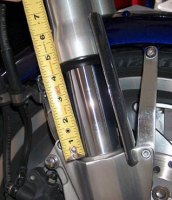
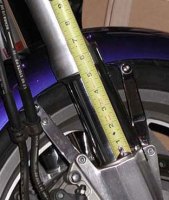
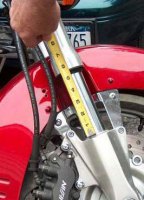
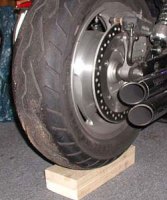
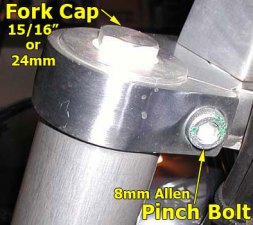
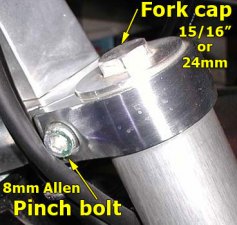
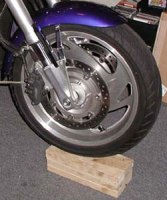
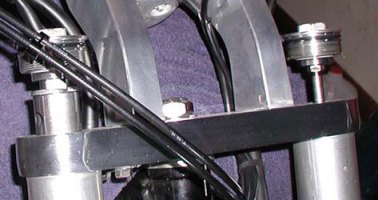
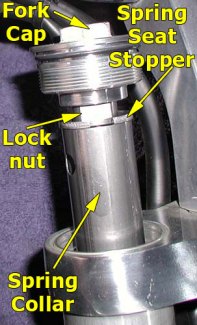
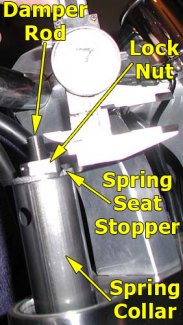
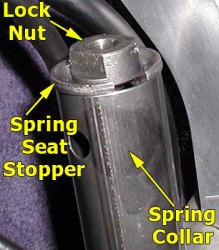
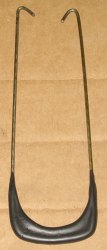
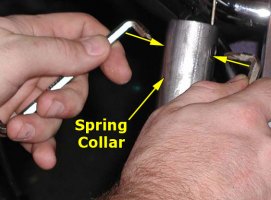
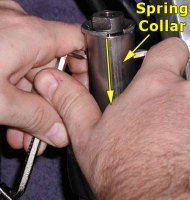
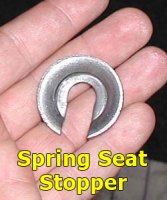
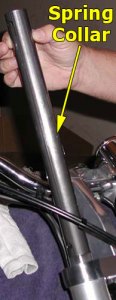
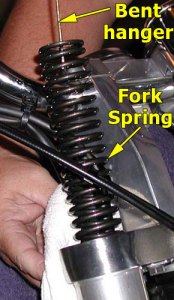
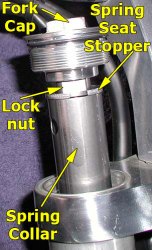
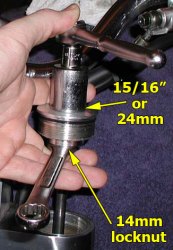
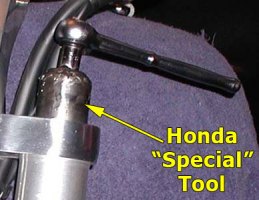
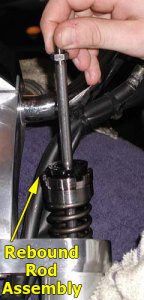
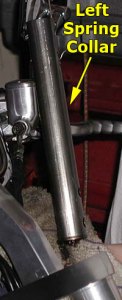
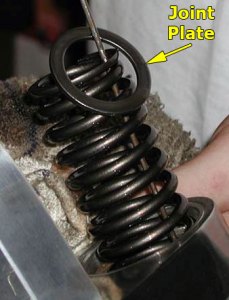
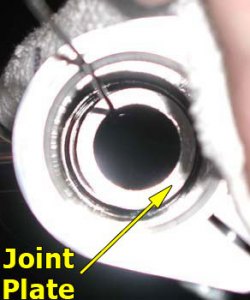
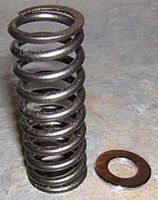
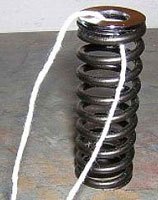
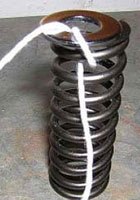
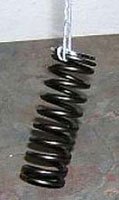
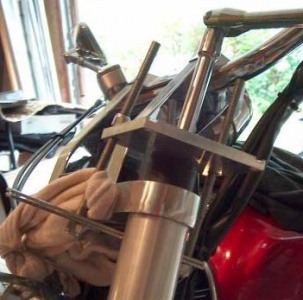
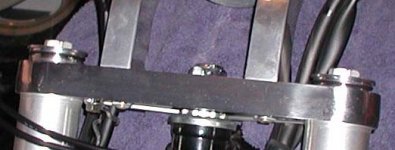
These instructions made my life MUCH easier. Step by step – easy.
Thanks very much – May the Force be with thee
I have had problem with, what I though was the front end bouncing down the road and after reading the article You have found my problem!!! I have Stump works chrome forks and wondered why the forks never matched up when I put on the wheel. Your explanation was right on!! 30 mins worth of work and its right on! Thanks, Great site!!!
Was easy following these instructions. My dealer wanted $350.00 to put in new springs. This cost me the price of the special tool 32.00 and some oil.
Thanks!
Installed progressive last month on my Valk and everything went as you said. I did use a stubby ratchet to push down the spring collar to remove spring seat stopper. Bought it at Home Depot or Sears. Forget already. But something like $4.00.
http://2.bp.blogspot.com/-tNJQ5hF-6es/TkyDaXOyNFI/AAAAAAAAEH0/zD9XnBKlJ5E/s1600/Bareass%2B_A.png
thanks!
P.S., even referred somebody else to this page and he was more than pleased.
I just installed my progressive shocks last night. Took only 2 hours with these instructions, but I discovered a few extra tips:
Instead of using a coat hanger to make the U-shaped tool, use the frame from and election lawn sign. They are very sturdy and big enough to get your foot in there. A little hard to bend the ends but once they’re bent, they will not unbend.
Also, to hold that washer flat on top of the new spring, put a little fork oil between the spring and the washer, hook
the hanger to the front of the spring then gently guide it down.
My 2007 C1 did not have springs in it like shown in the picture. The coils were the same spacing all the way up. I trust this web site and I am thinking Honda ran out of stock springs and threw these in.
I made my own tool for the left fork, easy to do if you have Auto Cad to print out the key pattern to scale and glue it on the pipe end to cut out the pattern.
I had more problems with the right fork spring than the left other than the washer that sets on to p of the spring. I did as Wharriso said and it worked, there was not enough room for the string to be pulled out. I installed the ratchet on the “honda” tool and used it to push down while the other hand turned the tool. Went on easy. You should be able to tighten it all the way down then get out the torque wrench.
I also had to adjust my fork to be the same length factory had them off by almost 1/4″ What id did was measure the cap to the center line of the front axle with the wheel up. I did this because the caps were not hitting at the same time and I want this to be right.
Thanks again for the post. I’ll be sure to pass it on.
To answer Kevin Honnoll’s statement regarding his springs having even spacing like the Progressive Spring. Honda switched to this type of spring in the 2005 model year 1800C and F. Not sure if the same was true for the R/S/T/N. I found that out when I went to change my OEM springs to Progressive and found the same thing he did. I checked Honda’s Parts Fiche and found that they did indeed change to the Progressive type spring.
[…]this is a write up on a vtx1800 fork spring change, it is pretty much identical to the mean streak, except maybe sizes of things[…]
My son and I just did this on my 2006 1800C and it didn’t have progressive springs, it had even spaced stock springs which was a bit o a surprise. Your instructions worked perfectly, but we used a motorcycle jack on the bike and a regular floor jack under the front wheel which allowed us to move the front wheel up and down through the process, making it a bit easier. I had already swapped out the back shocks with progressives, and that really helped with the bumps. The front springs didn’t do much for the bumps, but they did a fantastic job f making the bike feel much more stable. No more nose dives in the curves or during breaking. I’m really happy with the change.
i replaced my front springs with the Gold wing progressive springs ,they ride great take bumps great but im having a problem if i hit a real good bump the springs compress and take the bump good but they clunk HARD when they rebound.what could be done about that,or should i just go with the regular vtx 1800 progressive springs.
[…] You can adjust it so the axle lines up properly. […]
[…] Here’s everything on how to set the forks; […]
Going to be getting into this sometime in the next week. GL1800 progressive springs and 2″ fork extensions. Glad this resource is here for us. Cheers and thanks for the great help you always provide the VTX community.
Wow! I’m so glad I saw this page, as I was dreading the removal of the front end…….just got done changing the seals a few months ago, and had to disassemble the front end and take the forks i to the dealer to take the left one apart……had to buy a fat seal installer for that one…$85………had to pay $144 for the special tool this time around, crap…..why not.
If anyone wants to rent the special tool from me, it’s $20 plus postage. Change the seals and dust boots at the same time. Please contact me. It’s a lot of money, and the only time you’ll use it is to change springs and seals…….springs will last forever, a drastic improvement BTW
The goldwing springs are are the way to go if you ride hard way better feel and control of the front end. And a great work up on how to remove and replace with out all the bullshit of dealing with the dealership. Thanks.
Just found that progressive makes a gas filled mono tube spring setup for the 01-17 goldwing and body have any ideas if it’ll drop in on the vtx so we can upgrade the front even more. The mfr # 31-2511